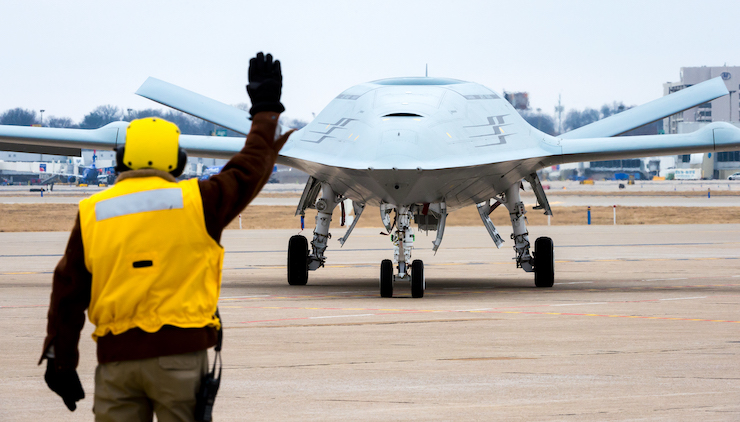
In 1997, the Harrison Ford action film “Air Force One” was the 5th highest grossing film of the year earning $315 million worldwide. The film is about a president trying to rescue all of the members on board Air Force One after it has been taken over by a team of terrorists. A pivotal scene in the movie is when a planned aerial refueling mission takes place to allow the terrorists to reach their final destination. Unbeknownst to the bad guys, the president, and his team use this moment to free the hostages strapped into parachutes as the plane lowers to refueling altitude. Spoiler alert, the mission doesn’t go as planned.
The tanker jet, in this case, a KC-10, has to break away causing fuel to spray out of the fuel probe. Sparks ignite, travel up the boom, and the KC-10 explodes. Though this satisfied the dramatic theme of the movie, it is not what would have happened if an emergency happened during a true aerial refueling mission. Onboard the refueling jet would be a designated boom operator. The boom is the telescope like hose that connects the two aircraft to transfer the fuel. The operator has total control of the boom and the fuel being pumped into the receiving plane. If an emergency were to happen, the operator would have no problem immediately shutting off the fuel supply, disconnecting, and retracting the boom.
But what if there is no boom operator, or even a pilot onboard a refueling jet? This is one of the questions Boeing had to address when developing a drone that could be used to refuel inflight aircraft, as per an objective of the United States Navy. Aiding Boeing in this mission was a team of 19 worldwide, cross-industry experts. On September 19, 2019, the drone was ready for its first test flight. After being certified for airworthiness by the Federal Aviation Administration, the MQ-25 autonomously took off from a runway at Scott Air Force Base in St. Louis, MO. “Seeing MQ-25 in the sky is a testament to our Boeing and Navy team working the technology, systems, and processes that are helping get MQ-25 to the carrier,” said Boeing MQ-25 Program Director Dave Bujold. “This aircraft and its flight test program ensures we’re delivering the MQ-25 to the carrier fleet with the safety, reliability, and capability the U.S. Navy needs to conduct its vital mission.”
The MQ-25 is a 51ft long drone powered by a Rolls-Royce AE 3007N turbofan. The engine gives the drone 10,000 lb perforce of thrust to cover a range of 500 nautical miles. The drone’s stealthy body shape has foldable wings. When folded the wingspan is only 31ft, but when extended the wingspan reaches 75ft. The drone can carry up to 15,000lbs of fuel. This fuel is transferred to an awaiting aircraft from a boom housed under one of the MQ-25’s wings. The MQ-25 has spent more than 30 hours in the air since the initial test flight in 2019. Each of these flights was to validate the aerodynamics and computer systems that would eventually turn the drone into an actionable aerial refueling vehicle.
The hard work paid off on June 4, 2021, when Boeing and the Navy conducted an inflight, unmanned refueling with the MQ-25. The drone autonomously took off from MidAmerica Airport in Mascoutah, IL. It flew along a preprogrammed course to meet up with a F/A-18 Super Hornet at the Air Test and Evaluation Squadron VX-23 based out of the Naval Air Station Patuxent River, MD. The trial lasted a little over 4.5 hours and put the drone through a number of tests. The first part of the test was to fly the drone in close formation, as close as 20ft apart, with the jet. Next, it was time to remotely deploy and attach the boom from the MQ-25 to F/A-18. The drone completed several refueling tests with both wet and dry connects. The refueling test lasted a little over 10 minutes, with the drone transferring 325lbs of fuel to the jet.
The test has proven that the US military can successfully operate a fleet of unmanned aerial refueling vehicles. This will allow aircraft to cover greater distances while keeping fewer people in the skies. A factor that ultimately saves time, money, and lives. Though catastrophic refueling accidents like the one featured in the film Air Force One are unlikely, each flight can pose a risk to the pilots involved. All of the participating teams were ecstatic with the results of the June 4th test flight. As Leanne Caret, president and CEO of Boeing Defense, Space & Security said, “This history-making event is a credit to our joint Boeing and Navy team that is all-in on delivering MQ-25’s critical aerial refueling capability to the fleet as soon as possible. Their work is the driving force behind the safe and secure integration of unmanned systems in the immediate future of defense operations.”
|